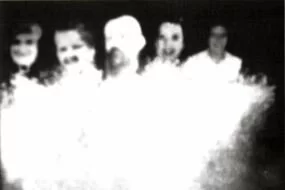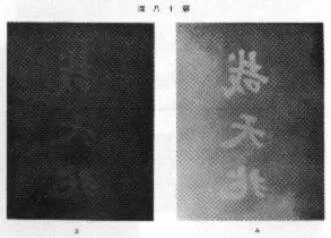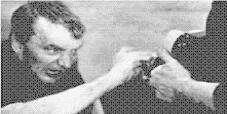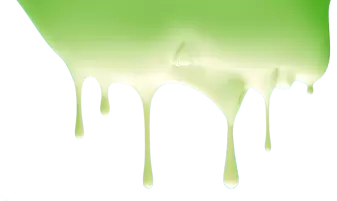Welcome to our thought photography and psychic photography section...
Thought photography (thoughtography), or psychic photography, is the creation of images on photographs through either psychokinesis, or mediumship with ghosts.
What Is the Difference Between Thought and Psychic Photography?
Thought photography (also known as nensha or projected thermography) is, more specifically, the ability to imprint an image from one’s mind onto surfaces, such as a photographic plate or film. In contrast, true psychic photography uses a psychic medium who is somehow able to connect with deceased people and enable them to appear on photographic film.

Fukurai Thought Photograph

Thought Photography Picture

Skotograph Spirits
Hans Holzer and Psychic Photographers
Famed ghost hunter Hans Holzer has worked with who he deems “psychic photographers” and has concluded that these people indeed possess a special form of mediumship. Holzer believes that psychic photography is a gift that only some possess. This may account for why some people seem to have the ability to capture fantastic ghost pictures, while others cannot. Hans has used psychic photography on investigations and claims that if a ghost was present they would be able to photograph it. Hans Holzer carefully observed psychic photographers at work, noting that the film and camera was not tampered with. On one such investigation, a white figure that was unseen appeared behind Hans’ ex-wife.
Origins of Psychic and Thought Photographs
The roots of thought and psychic photography actually goes back to the 1850s and the Spiritualist Movement. The Spiritualists believed that the human spirit existed beyond the body and that disembodied spirits can communicate with the living. As the Spiritualist movement grew larger into the twentieth century, spirit photography became a hotly debated topic by major intellectual figures of the day, such as Sherlock Holmes author, Sir Arthur Conan Doyle. During the movement, photographic experiments progressed with thoughts, feelings, and dreams being captured directly on the photographic plate, or onto film. Some photographed their own thoughts by placing their fingers or foreheads directly onto the photographic plates. Some believed the discovery of X-ray photography in 1896 gave the spirit photographers scientific legitimacy.  The experiments in thought photography continued into the 1900s by men such as Japanese Tomokichi Fukurai in the early 1900s, Russian Semyon Kirlian in the 1940s, American Ted Serios in the 1960s, and Israeli psychic Uri Geller in the 1990s.
The experiments in thought photography continued into the 1900s by men such as Japanese Tomokichi Fukurai in the early 1900s, Russian Semyon Kirlian in the 1940s, American Ted Serios in the 1960s, and Israeli psychic Uri Geller in the 1990s.
Nensha Photogaphy
Tomokichi Fukurai, an assistant professor of psychology at Tokyo University, worked to prove his theories regarding nensha (spirit photography). In 1913, Fukurai worked with a woman named Sadako Takahashi, who claimed to have developed both clairvoyance and thought photography through breathing and mental exercises. Eventually they published a book together entitled Clairvoyance and Thoughtography. Fukurai would later work with another thoughtographer who created a thoughtograph of the dark side of the moon. (Example of Tomokichi Fukurai nensha or thought photography.)
 Ted Serios: Thinking Images Onto Polaroids
Ted Serios: Thinking Images Onto Polaroids
Serios became notorious for the production of thought photography on Polaroid film. He supposedly used only psychic powers while in a drunken (and often enraged) state. Serios' thought photographs looked similar to postcard scenes. He was able to produce his photographs while holding a tube from the camera lens to his forehead. Serios claimed he needed this tube to help him concentrate and project the mental images, but several people noticed him slipping something into the tube to create the images. Many attributed his drunken fits and outbursts to only being disturbing distractions, while he worked his occasional “sleight of hand” into supposed thought or psychic photographs. (Ted Serios attempting to produce one of his thought or psychic photographs.)
Uri Geller Thought Photographs on Film
Illusionist, Uri Geller, began to perform thought photography by using a 35mm camera with the lens cap affixed. He would reportedly then take photos of his forehead. When the photographs were developed, Uri claimed that the images had come directly from his mind.
Interestingly, camera expert and witness Lawrence Fried used his own assistants to help him watch Uri and examine all aspects of Geller’s process. Fried was convinced there was no way Geller could have tampered with the camera or the film, as new film was used, the camera lens cap taped to the camera, and the film developed by an outside lab of Fried’s choosing. However, magician and paranormal debunker James Randi still criticized Geller, claiming that all thought photography is simply deception created by using either a handheld optical device (something in front of the lens) or by taking photographs on film that’s been pre-exposed (tampered with).

